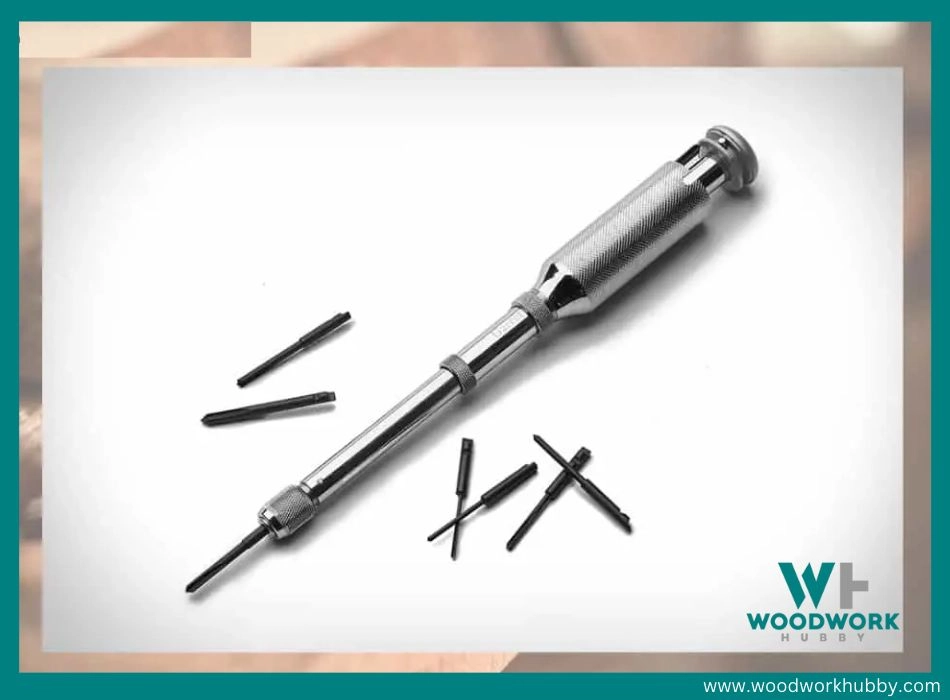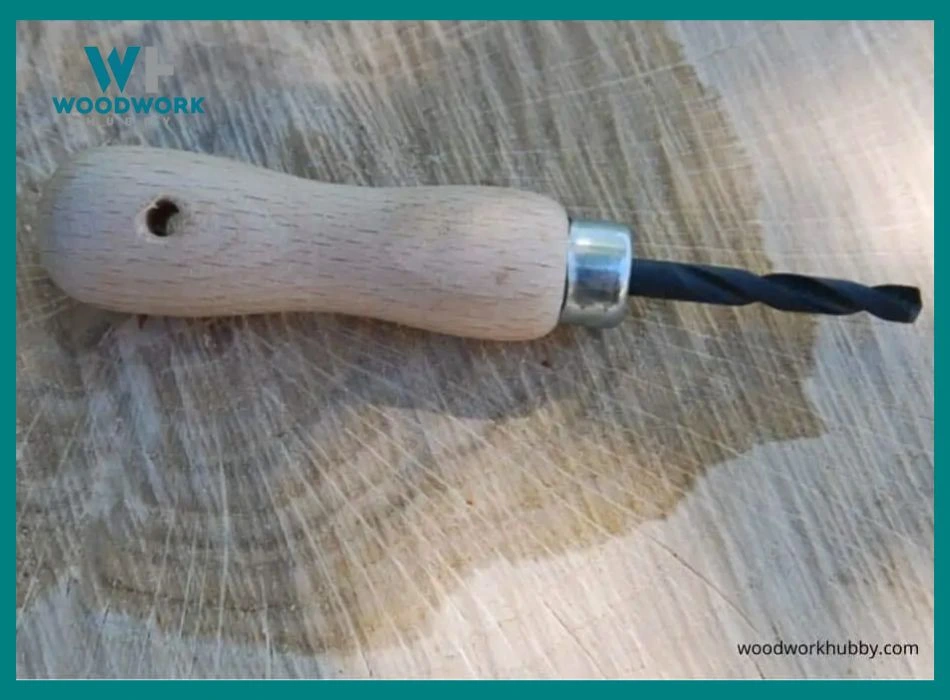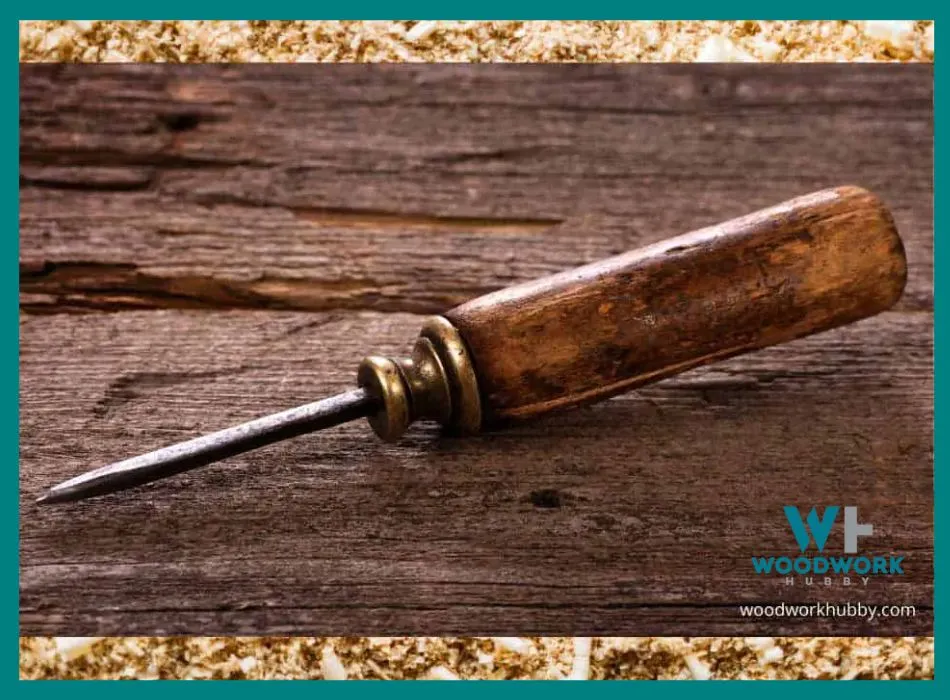You were supposed to charge up your power tools last night for an afternoon of woodworking today, but you forgot. That doesn’t mean you have to put your woodworking project on hold! You can cut holes in wood with plenty of other tools besides the battery-powered variety. How to cut a hole in wood without power tools?
Here are 7 tools to cut a hole in wood without any power tools:
- Push drill
- Bow drill
- Palm drill
- Awl
- Brace and bit
- Gimlets
- Hot coals
Some of these tools might be familiar to you while others are completely new. Make sure you keep reading, as I’ll explain everything you need to know. I’ll also talk about whether you can cut a hole in wood by hand, so you won’t want to miss it.
These Are the 7 Best Ways to Cut a Hole in Wood Without Power Tools
1. Push Drill

Before power drills were the norm, most drills required you to make holes manually. Such is the case with a push drill. Some people regard push drills as a forgotten relic while others find them useful even today.
That’s because they are! If a scenario like what we described in the intro transpires where your power tools are out of juice, a push drill is always there for you to use. It’s quite reliable.
So how exactly does a push drill work? Like other drills, push drills have bits that go into the handle. You select a bit and then insert it into the drill’s pointed edge, locking it into place. Then aim the push drill’s point on the piece of wood you want to cut, placing it on the precise area to make a hole.
When you apply pressure on the drill, its internal screw thread will rotate the bit, creating what will become a hole. This isn’t instant, mind you. When working with softwood, it takes a couple of strokes to make a mark into the wood that’s even half an inch deep.
The diameter of the holes that a push drill can make is between 1/16th inches and 5/32 inches. That won’t work for all projects, but for those precision jobs where you want to make a tiny hole, a push drill truly comes in handy.
2. Bow Drill

Here’s another option for you, a bow drill. Bow drills are two-part tools that are ancient, even more so than push drills. It’s believed that early versions of bow drills existed sometime in the fourth or fifth millennium BC.
The bow drill features a rod that’s known as a drill shaft or spindle. By encircling the bow drill with a cord, the rod begins moving. The other part of the drill is the eponymous bow that you move with your hand.
Bow drills can puncture holes not only into the wood but materials like stone and even teeth and bone. You can also use this tool like a fire drill to start fires such as when camping or in a survival situation.
You would have to make amendments to the bow, though. For instance, the shaft part of the fire bow should be blunt, and you need a fireboard as well. This is a portion of wood with a cavity. As you rotate the shaft, the combination of pressure and speed will create heat, making powdered charcoal that can start a fire.
3. Palm Drill

Palm drills work when your power tools don’t. Also known as hand drills, palm drills are those that you use by hand to cut holes into wood. Some are softwood drills for puncturing that type of wood while others can handle harder wood.
You can select the diameter of a palm drill, with the sizes available from two millimeters up to four millimeters and sometimes larger. Since palm drills are all about your hand dexterity, cutting a hole into the wood with one of these drills is as easy or difficult as it is to maneuver the drill.
If you’re prone to hand fatigue, then your time with a palm drill can be awfully short-lived. Like when using any muscle though, the more often you work it, the easier it becomes to use the drill for longer periods.
4. Awl

An awl might look like a screwdriver at first glance, but it’s its own unique tool. The end of the awl is pointy.
These awls are known as scratch awls, and yes, there’s a difference between them and stitching awls. The former is intended for woodworking and the latter for stitching into canvas or leather. You cannot use these awls interchangeably.
The hole you make with a scratch awl won’t be particularly deep. Really, these tools are intended for creating a mark that you can then insert a drill bit into to finish the job. For softwoods, you might be more easily able to get an awl through the wood.
5. Brace and Bit

Still a favorite of mine and works very well! The brace and bit include a bit, which makes holes in the wood. The brace is a crank that you turn. The other parts are a handle, a ratchet (which is attached to the handle), and the shell. The shell is where the bit is connected to.
The long spiral shape of the bit has twists throughout. On the end, known as the spur, are two cutting lips on either side of the feed screw, which is in the center.
Like when using a palm drill, since it’s all manual rotating to make a brace and bit work, this is going to take hand and forearm strength. If you’ve only ever used power tools in your woodworking projects to this point, it can take time to strengthen your muscles to handle the effort needed to make a hole in wood using a brace and bit.
6. Gimlets

You might have heard of the alcoholic beverage called the gimlet, but in woodworking, this tool is something else entirely. Gimlets have existed since at least the 1850s, as Joseph Gwilt described the tool in his 1859 book Architecture.
See the other great books I recommend for Woodworking.
So what exactly is a gimlet? It’s a tool that looks like a screwdriver and is sized to a screwdriver as well. It has a screw-like point, unlike an awl. After piercing a hole through the wood, the gimlet’s spiral-shaped cutting edges on the side can widen the hole. You also don’t have to put any extra pressure on the gimlet after piercing through wood with it.
7. Hot Coals
If your power drills are dead and you’re lacking all the above tools, you do have one more option. We’d only recommend it as a last resort, but it’s how civilization used to make holes in wood before drills existed.
Yes, I’m talking about burning wood. You need hot coal that goes on the wood where you want the hole. Holding the coal with tongs will allow you to keep its placement precise. You can even heat up a wire from a clothes hanger and use that to make very tiny holes.
Since working with fire can be unpredictable and thus dangerous, this option isn’t advisable if you can use any other tool. You’re much better off waiting until you have the proper tools, even if that takes a while. Besides, even if you did use coals to make holes in the wood, the size of the holes would be inconsistent.
How Can You Drill a Hole Without a Drill?
Holes can be drilled in wood using a variety of hand tools such as a Brace and Bit, push drill, or a palm drill. These are not your regular everyday power tools, although they still do a great job of making a hole if you are in a pinch.
An awl is yet another drill-less option for making holes in wood. Plus, you could always heat up wire and make small holes that way even if it’s not the safest idea.
How to Cut a Hole in Wood Without a Jigsaw
Besides your power drills, you’re quite fond of your jigsaw for woodworking. These saws have reciprocating blades that can slice stencils and shapes.
You lent your friend your jigsaw the other week without realizing that you’d need it now. You don’t want to ask for the jigsaw back early, but you’re not sure how to proceed with your woodworking project.
If you want a slice a circular hole in wood, you don’t need a jigsaw, per se. You can try these other methods instead.
Sandpaper + Coping Saw
With sandpaper, a coping saw, and a compass, you’ll cut wood like you used a jigsaw. Take your piece of wood and find where the middle of the circle will be. Then mark it down. Using your compass, adjust it until you get to the radius of what your circle will be. Then draw an outline of that circle with a pencil.
Grab your coping saw and slice around the circle. The coping saw will not leave the exterior of the circle smooth, but that’s okay. This is what your sandpaper is for. A sandpaper machine will save you time and manual effort, but if all you have are a few pieces of sandpaper to rub around the perimeter of the circle, that works too.
Pinning + Drilling
The second option is for when you have rectangular or square-shaped pieces of wood that you want to cut a circle into. The wood should be about two inches wide. Pin the wood and then drill where you made the pinholes. It’s that simple!
How to Cut a Hole in Wood by Hand
There’s something about cutting wood by hand that’s so satisfying. Maybe it’s the simplicity of it all, knowing that thousands of years ago, people cut wood like this, and here you are now in the 21st century doing the same.
With a hand drill, an awl, or a gimlet, you can experience the fun of cutting a hole into wood by hand. As I talked about earlier though, all this handiwork (yes, pun intended) is harder than it looks. You need to use many muscles in your hands and forearm to cut the wood when you do it manually.
My suggestion is to take breaks often, as your hands and arms are going to hurt at the beginning. Still, don’t give up. You’ll get better at handsaws and other hand tools the longer you use them, as your muscles will tone up.
How to Cut a Hole in Wood Without Going All the Way Through
The following methods work best for drilling a hole without going all the way through:
- Drill bit in a drill press with depth stop
- Wrap masking tape around your drill bit
- Use a small block of wood on your drill bit as depth stop
- Use a router with a straight bit
- Forstner bit as it has a small spike
You want to make a hole in some wood, but you don’t want the hole to pierce all the way through. Use an awl! This tool will begin to make a hole that you can later finish with your power drill or another of the tools discussed in this article.
Final Thoughts – 7 Ways To Cut A Hole In Wood WITHOUT Power Tools
Power tools are an innovation that many woodworkers use all the time, but they’re not your only option. When your power tools stop working or run out of battery, you can use hand saws, awls, brace and bits, and even fire to make a hole through wood. Best of luck!




